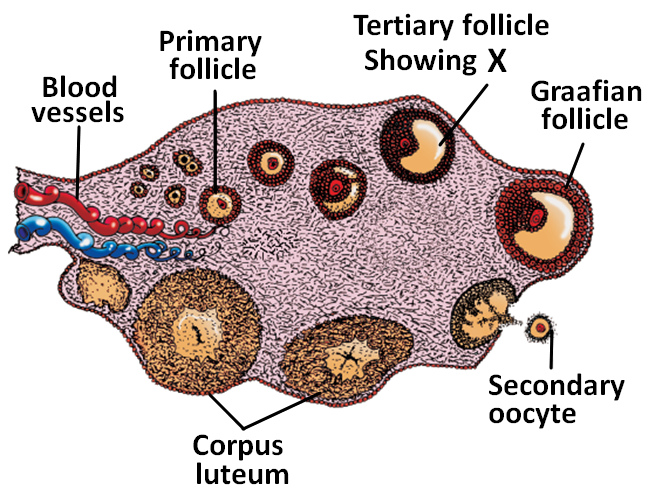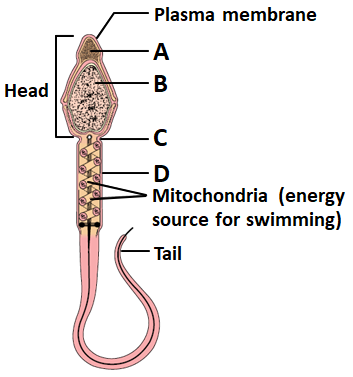Select Question Set:
There are remarkable differences between the reproductive events in the male and in the female, including:
1. Only I is correct
2. Only II is correct
3. Both I and II are correct
4. Both I and II are incorrect
| I: | sperm formation continues even in old men, but formation of ovum ceases in women around the age of fifty years. |
| II: | sperm formation begins in foetal life and egg formation begins after the onset of puberty. |
1. Only I is correct
2. Only II is correct
3. Both I and II are correct
4. Both I and II are incorrect
Subtopic: Seminiferous Tubules & Spermatogenesis | Spermiogenesis/Sperm Structure/Hormonal Regulation | Male Reproductive Duct System |
91%
Level 1: 80%+
Please attempt this question first.
Hints
Please attempt this question first.
What is the advantage of the descent of testes in humans from the lower abdomen to the scrotum?
| 1. | Better thermo-regulation leading to effective spermatogenesis |
| 2. | Ease of transport of the sperms to the urethra |
| 3. | More storage space for sperms |
| 4. | A decrease in the risk of prostatic hypertrophy |
Subtopic: Male Reproductive System |
94%
Level 1: 80%+
Hints
Identify the correct match for A, B, C and D in the given figure:


| A | B | C | D | |
| 1. | 46 | 46 | 23 | Second |
| 2. | 46 | 23 | 23 | Secondary |
| 3. | 46 | 23 | 23 | Second |
| 4. | 23 | 23 | 46 | Secondary |
Subtopic: Seminiferous Tubules & Spermatogenesis | oogenesis |
71%
Level 2: 60%+
Please attempt this question first.
Hints
Please attempt this question first.
After implantation, finger like projections appear on the trophoblast cells called:
| 1. | Chorionic villi | 2. | Allantois |
| 3. | Decidua | 4. | Sinusoids |
Subtopic: Implantation : Part 1 |
96%
Level 1: 80%+
Hints
What is ‘X’ called in the given figure?


| 1. | ampulla | 2. | antrum |
| 3. | blastocoel | 4. | enterocoel |
Subtopic: Female Reproductive System-1 | Female Reproductive System-2 |
92%
Level 1: 80%+
Please attempt this question first.
Hints
Please attempt this question first.
During the follicular phase of the menstrual cycle, which of the following occur?
| I: | The primary follicle grows and becomes a fully mature Graafian follicle. |
| II: | The endometrium of the uterus regenerates through proliferation. |
2. Only II
3. I and II
4. None
Subtopic: Menstrual Cycle |
81%
Level 1: 80%+
Hints
Which alphabet in the given figure represents the structure that carries two pairs of centrioles?

1. A
2. B
3. C
4. D

1. A
2. B
3. C
4. D
Subtopic: Male Reproductive Duct System | Semen and Male Fertility |
59%
Level 3: 35%-60%
Please attempt this question first.
Hints
Please attempt this question first.
What maintains the functions of male sex accessory ducts and glands in humans?
1. Releasing hormones from the hypothalamus.
2. Pituitary gonadotropins.
3. Steroids from adrenal cortex.
4. Testicular androgens.
Subtopic: Seminiferous Tubules & Spermatogenesis |
74%
Level 2: 60%+
Please attempt this question first.
Hints
Please attempt this question first.
During pregnancy, the levels of thyroxin:
1. Increase several folds in maternal blood
2. Increases several folds in fetal blood
3. Decreases several folds in maternal blood
4. Decreases several folds in fetal blood
Subtopic: Fetal Development & Parturition |
90%
Level 1: 80%+
Hints
Match each item in Column-I with one in Column-II and select the correct match from the codes given:
Codes:
| Column-I | Column-II | ||
| A. | Insemination | P. | embryonic development |
| B. | Implantation | Q. | transfer of sperms into the female genital tract |
| C. | Gestation | R. | delivery of the baby |
| D. | Parturition | S. | attachment of blastocyst to the uterine wall |
| A | B | C | D | |
| 1. | Q | S | R | P |
| 2. | S | Q | R | P |
| 3. | Q | S | P | R |
| 4. | S | Q | P | R |
Subtopic: Implantation : Part 1 | Implantation : Part 2 |
92%
Level 1: 80%+
Please attempt this question first.
Hints
Please attempt this question first.
Select Question Set:






